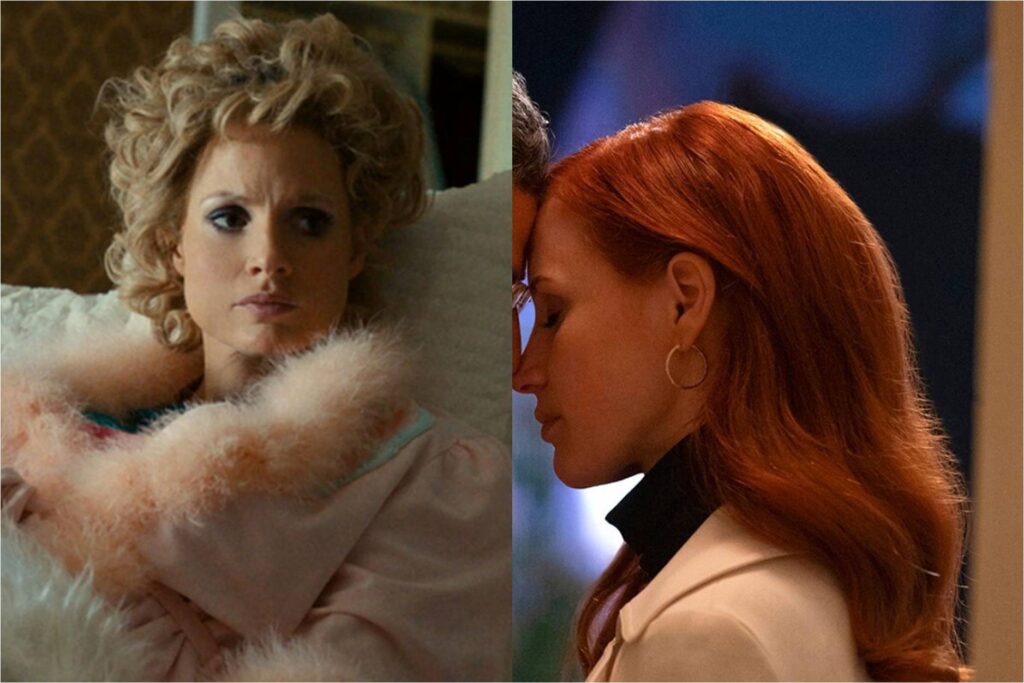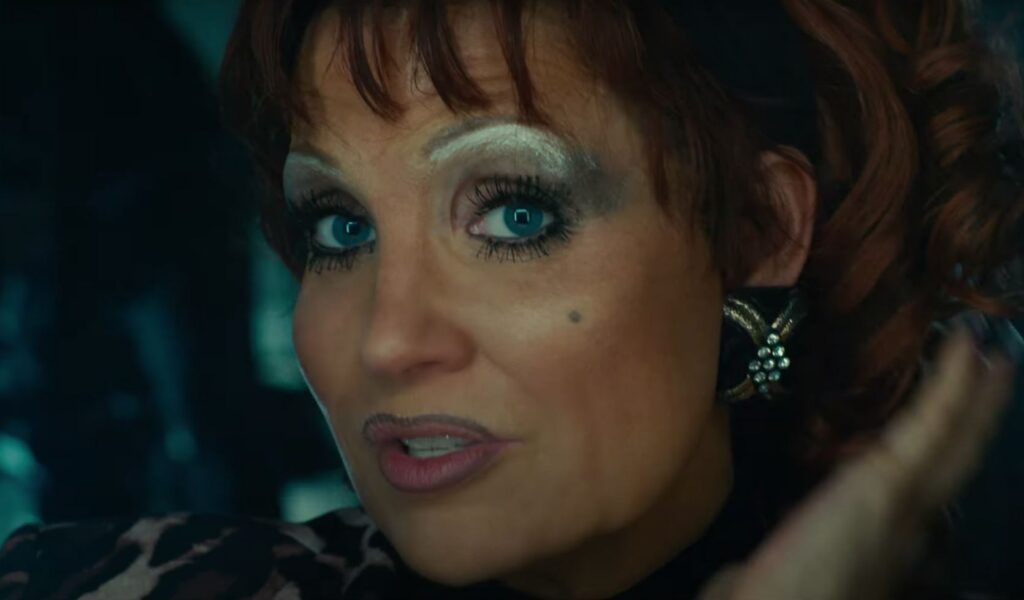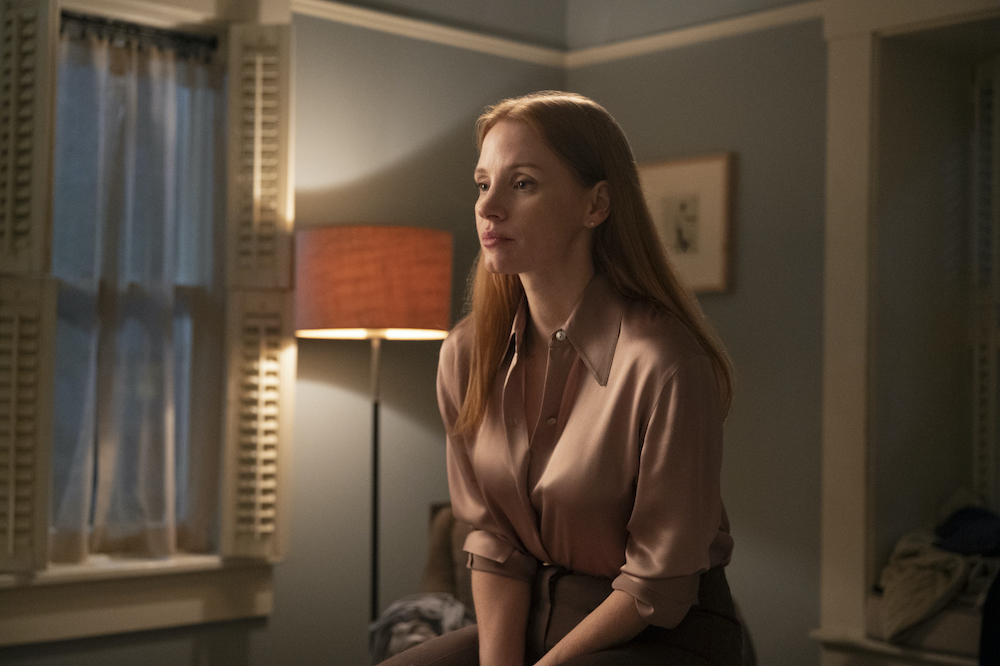
The Eyes of Tammy Faye, the new biopic from Michael Showalter, is the kind of movie that features a lot of stuff. There are a lot of wigs and mustaches. There are a lot of exaggerated accents, both midwestern and southern. There are a lot of title cards, informing us of the year and location as we race through five decades and across quite a few states. There are a lot of period-specific songs and chintzy costumes. And, thanks to an Oscar-hungry Jessica Chastain, there is a lot of acting.
Which isn’t the same thing as overacting. It wouldn’t be accurate to say that Chastain disappears into the role of Tammy Faye Bakker, the popular televangelist who fell from grace in the late ’80s; over the course of the movie, even as the redheaded actor becomes increasingly difficult to recognize under heaps of artificial black-and-blonde hair and facial prosthetics, it’s always clear that you’re watching a performance. But that’s the point. As described in Showalter’s film, Tammy Faye built her following through a combination of sincere sweetness, uncommon pluck, and sheer force of will. In attempting to convey that degree of boisterous charisma, Chastain’s technique is similarly bold and visible. Rather than modulating the part with her usual steely presence, she leans into the eccentricity—chewing over every Minnesota-inflected syllable, cackling with every laugh, turning on the waterworks as tears stream through her heavy makeup. It’s an outsized performance designed to fit a larger-than-life figure.
As a piece of cinema, The Eyes of Tammy Faye is pretty lousy. It suffers from the same disease that afflicts many biopics in that it seeks to condense years of a complex person’s life into an easily digestible two-plus hours (a hopeless task). Showalter, a comedian by trade (he’s probably still best known for Wet Hot American Summer, though he proved his storytelling chops with The Big Sick), struggles to enliven the garish sets with any visual flair, aside from the occasional splash of color. (The phone banks where the Bakkers solicit their pledges are painted an aggressively cheery sky-blue.) Andrew Garfield, who plays Tammy Faye’s fraudster husband Jim, is poorly served by direction that emphasizes his simpering high-pitched accent above all else. And thematically, the film is frustratingly empty; it strikes a few glancing blows against the misogynistic hypocrisy of the Christian right (Vincent D’Onofrio gobbles some scenery as Jerry Falwell), but it never really explains the Bakkers’ appeal, and its predictable veer toward tragedy is shrill and stale.

So, not a very good movie. But it’s still worth considering for Chastain’s performance—not just for its independent vigor, but for how it compares to her other recent star turn. Five days before Searchlight feebly plunked Tammy Faye into 450 theaters (where it dredged up a pitiful 652 thousand dollars), HBO released the first episode of Scenes from a Marriage, its remake of the 1973 miniseries from Ingmar Bergman. Chastain stars opposite Oscar Isaac (whom she previously worked with in A Most Violent Year) as Mira, a character as far removed from Tammy Faye as the Twin Cities are from Sweden. With her flowing red hair, alabaster skin, and curt demeanor, Mira looks and sounds like… well, an awful lot like Jessica Chastain. Yet two episodes into this oddly riveting series, it’s clear that the actor is delivering another powerful performance, albeit nothing like her flashy work as the smiling grifter. Whereas Tammy Faye is bright-eyed and vivacious, Mira is clenched and reserved, bottling up her emotions until they leak out of her like bile. It’s the kind of unnervingly poised vanishing act that bleeds actor with character—the exact opposite of the ostentatious dynamism she supplies as Tammy Faye.
And yet, the two turns are strangely unified in how crisply they communicate their intent. Consider the opening scenes of each. In Tammy Faye, we begin with a close-up of an unrecognizable Chastain chatting with an assistant. The year is 1994, and the 52-year-old Tammy is describing how her false eyelashes and black lip lines are now permanently affixed to her face. “This is me,” she says, a declaration which makes clear the artificiality of the coming performance, even as it signals Chastain’s enthusiastic commitment to the role.
In a sense, the introduction to Scenes from a Marriage could scarcely be more different. When we first see Chastain, she isn’t just playing a character who physically resembles herself; she literally is herself, strolling past a masked film crew and receiving instructions from a production assistant who calls her “Jess” as she takes her place on set. An offscreen voice calls for a slate, and then, as the camera starts rolling and the color grading sharpens, Chastain invisibly assumes the part of Mira, glancing at a message on her phone whose significance won’t be known for the better part of an hour. The intimation here is in some ways the reverse of Tammy Faye—rather than watching an actor playfully impersonate a historical figure, you’re witnessing the collapse between a real person and a fictional one—but the effect is the same, clarifying the tone and style of the ensuing work.

Oddly enough, this isn’t the first time Chastain has occupied both sides of the acting spectrum in relatively close proximity; her first two Oscar nominations came for roles that were similarly oppositional. In 2011’s The Help, she shined as happily clueless flibbertigibbet oblivious to the miasma of racism surrounding her; in the following year’s Zero Dark Thirty, she suppressed that charm as a CIA agent who camouflaged her emotions in favor of taut intelligence and coiled restraint. It’s hardly unprecedented for thespians to swing from one stylistic pole to another—after all, acting is just pretending to be somebody else—but these early performances established an impressive range of technique that Chastain continues to refine and exploit a decade later.
The overlapping arrivals of Tammy Faye and Scenes from a Marriage raise the question: Is one of these methods of acting superior to the other? It is fashionable among film critics to admire rigorous, internalized portrayals, and to scoff at showboating imitations of famous people (which of course are catnip to Oscar voters, whom we mock except when we approve of their choices). I’m not immune to this line of thinking; perhaps my favorite performance of 2021 thus far is Rebecca Hall’s subdued turn in The Night House, which is riveting for how it builds a character through silence and stillness. It is more challenging, and thereby more noteworthy, for an actor to convey personality without resorting to campy accents and broad gestures. Chastain’s work as Mira—the way she subtly articulates depression, irritation, and helplessness without openly signaling any of those feelings—accumulates a brittle human honesty that her work as Tammy Faye never quite achieves.
And yet, her performance in The Eyes of Tammy Faye is mesmerizing on its own merits—not for its realism, but for its audacity. Watching the movie, we never really gain any insight into Tammy Faye Bakker’s troubled life, but Chastain’s goal isn’t illumination; instead, it’s transportation. She wants to carry us into a heightened universe of cheap hucksters, deep longing, and shattered dreams. Given how earnestly she flings herself into the part, we have no choice but to accompany her on her strenuous journey. And at that point, despite the blatant falseness of everything around her, the genuine emotions of Chastain’s performance start to seep in. It’s weird, and rather remarkable. Even when she’s slathered in makeup, she still finds a way to dig under the skin.
Jeremy Beck is the editor-in-chief of MovieManifesto. He watches more movies and television than he probably should.
